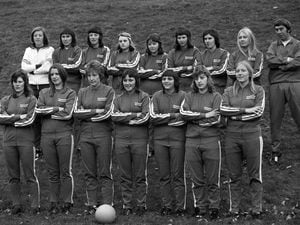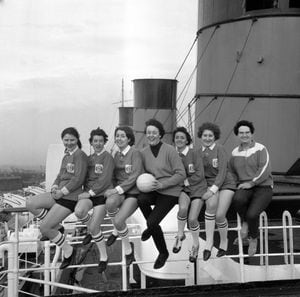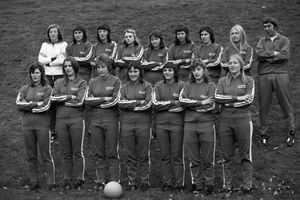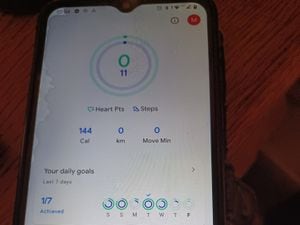Key moments from the history of women's football
With the World Cup about to kick-off in Australia, we look back at some of the key moments from the history of women's football.

The first recorded women’s football match was on 7 May 1881 when a supposed ‘Scotland’ women’s team played ‘England’ at Easter Road, Edinburgh.
According to the FA, the birthplace and therefore nationalities of the players has been called into question and it’s believed at least some of the players were from the theatre community ‘acting’ out these team roles.
The two teams played several matches, but two – in Glasgow and Manchester – were abandoned due to pitch invasions including one by a horse-drawn bus.
In the first match, Lily St Clair became the first recorded female goal scorer in the history of the game with her goal in front of a crowd of about 2,000.
Throughout the 1890s, women’s club football gained momentum and in 1895 the British Ladies’ Football Club (BLFC) was formed by Alfred Hewitt Smith.
President of the BLFC, Lady Florence Dixie, a renowned Scottish writer, adventurer, war correspondent and feminist, insisted players wore practical clothes, including bloomers, shin pads and proper boots, so they would be free to run around.
During the First World War, women increasingly took on traditionally male jobs, typically working in factories.
Sporting activity was encouraged to benefit health and wellbeing, as well as to help aid morale and productivity.
Football was a natural outlet for this and many factories developed their own teams.
By far the most famous and one of the most successful was Dick, Kerr & Co.
From 1917 right through to 1965 they played 800 games - winning 746. During and after the war, Dick Kerr Ladies toured the country playing charity games to raise money for injured servicemen.
By 1921 there were about 150 women’s football clubs with matches attracting up to 45,000 spectacular.
The future of the women’s game was looking bright.
But as many factories closed and women went back into domestic life or retrained in different professions, some people questioned whether football was damaging women’s health.
For example, Dr Mary Scharlieb of Harley Street described it as the “most unsuitable game, too much for a women’s physical frame”.
Then, on December 5,1921, The FA announced a ban on the women’s game from being played at the professional grounds and pitches of clubs affiliated to The FA, stating “the game of football is quite unsuitable for females and ought not to be encouraged.”
This decision would mean the women’s game was side-lined to being played in public parks for nearly 50 years.
Despite this, women were determined to keep playing football and around 30 teams from across England met in Liverpool on 10 December 1921 to formalise the English Ladies Football Association (ELFA). This aimed “to popularise the game among girls and to assist charity".
Women’s football carried on throughout the ‘30s, ‘40s, ‘50s and most of the 1960s. Games were played at rugby venues and smaller grounds which couldn’t house many fans.

In November 1969, representatives of 44 clubs attended the first meeting of the Women’s Football Association (WFA) in London.
The FA were coming under increasing pressure to lift the ban on women’s football and in late December 1969, some of The FA Committee agreed that “ladies’ football should no longer be considered to be classed as unaffiliated football”.And on 19 January 1970, The FA Council finally voted to rescind the 1921 resolution. Women could now play on grounds affiliated to the FA and registered referees could officiate women’s matches.
In November 1972, the first official WFA England team travelled to Scotland for an international match in which England came from behind to win 3-2.

The WFA continued to grow the women’s game throughout the 1970s, ‘80s and early ‘90s. In 1991 a 24-club national league was launched which the following year was expanded to three divisions of 10 teams.
And in 1993,the WFA voted to pass over its activities to The FA, which established a Women’s Football Committee and with it the full-time post of Women’s Football Co-ordinator.
The 1993/94 season also saw the WFA Cup brought under the control of The FA - 137 teams entered. A year later and the WFA’s national league and league cup were also managed by The FA. This saw the birth of the Women's Premier League (FAWPL).
FIFA introduced the women’s World Cup competition in 1991 and as the women’s game started to grow globally, the decade culminated in the finals in the USA in 1999 that featured sold-out stadia and a 90,000 crowd at the final.
Over the past two decades the game has grown further with a number of key achievements including smashing records for crowd attendance and TV audiences when England hosted the UEFA Women’s EURO in 2005.
The London 2012 Olympic Games gave women’s football in this country a further boost, when the Team GB Women reached the quarter-finals of their competition.
There have also been some major developments at grassroots level. In 2013, The FA, Sport England, The Premier League and The Football League Trust launched their first joint national participation programme for girls’ football.
This was followed by FA’s first formal strategy for women’s and girls’ football in England, unveiled in March 2017 with the goals of doubling participation, doubling the fanbase and achieving consistent success on the world stage.

Following the first three-year strategy, a new one – Inspiring Positive Change – was launched in October 2020. Among its eight goals, one stands out – to give every school-going girl the same access to football as boys, whether at school or in clubs.
UEFA Women’s EURO 2022 created over 400,000 new opportunities for girls and women to engage in grassroots legacy football activities.





